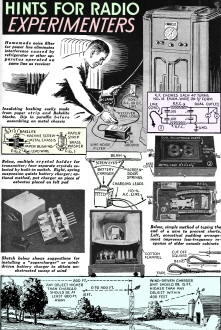| December 1937 Popular Mechanics |
 [Table of Contents] [Table of Contents]
Wax nostalgic about and learn from the history of early
mechanics and electronics. See articles from
Popular Mechanics,
published continuously since 1902. All copyrights hereby acknowledged.
|
In the early days of radio,
many people built their sets from schematics and a box full of parts. Often, obtaining
the required components was not such an easy task, either because of a lack of means
of knowing what was available from suppliers or due to lack of availability of needed
parts that were advertised as being ready for purchase. A lot of local electronics
repair shops sold components, as did many hardware stores. Still, fabrication of
one's own inductors, antennas, tuning capacitors and/or coils, chassis for mounting
all the components, etc., was required. Accordingly, science and electronics magazines
often ran a monthly feature presenting hints, kinks, tricks, and shortcuts submitted
by readers. The December 1937 issue of Popular Mechanics magazine published
this collection of "hints" which included a homemade filter for blocking interference
from appliances with electrically noisy motors (arcing from armature brushes) and
a means of isolating a possibly hot chassis from the power source. Poor design and
the lack of polarization on AC plugs meant there was a 50-50 chance the metal chassis
would be "hot." The plan for a wind-powered generator could easily be something
seen in a contemporary magazine. Back in the day, many rural locations had no commercial
electric service and relied on wind and water turbines to provide power to household
and farm implements.
Hints for Radio Experimenters
 Homemade noise filter for power line eliminates
interference caused by refrigerator or other apparatus operated on same line as
receiver. Homemade noise filter for power line eliminates
interference caused by refrigerator or other apparatus operated on same line as
receiver.
Insulating bushing easily made from paper strip and Bakelite blocks. Dip in paraffin
before assembling on metal chassis.
Below, multiple crystal holder for transmitter; four separate crystals selected
by built-in switch. Right, spring suspension quiets battery charger; optional method,
put charger on piece of asbestos placed on felt pad.
Sketch below shows suggestions for installing a "supercharger" or wind-driven
battery charger to obtain unobstructed sweep of wind.
Below, simple method of taping the end of a wire to prevent shorts. Left, acoustical
padding arrangement improves low-frequency response of older console cabinets.
Posted November 16, 2023
|










